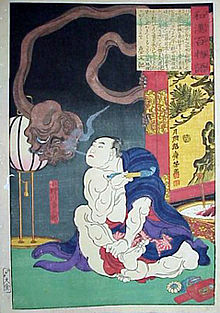- Onogawa Kisaburō
-
小野川喜三郎
Onogawa Kisaburō
Personal information Born 川村 喜三郎
Kawamura Kisaburō
1758
Shiga, JapanDied April 30, 1806 (aged 48) Height 1.76 m (5 ft 9 in) Weight 116 kg (260 lb) Career Heya Tamagaki Record 144-13-40
4draws-10holds-3no results
(Makuuchi)Debut October, 1779 Highest rank Yokozuna (November, 1789) Retired October, 1798 Yūshō 7 (Makuuchi, unofficial) * Career information is correct as of October 2007. Onogawa Kisaburō (小野川喜三郎, 1758 – April 30, 1806) was a sumo wrestler from Otsu, Shiga Prefecture, Japan. He was the sport's 5th Yokozuna. Along with Tanikaze he was the first to be given a yokozuna licence by the House of Yoshida Tsukasa and the first to perform the dohyō-iri to promote sumo tournaments.
Contents
Career
Onogawa was promoted to the top makuuchi division in March 1781. He defeated ozeki Tanikaze Kajinosuke in February 1782. The victory surprised people in Edo as it brought to an end Tanikaze's run of 63 consecutive victories. Onogawa became a rival of Tanikaze and was popular with the public, although in reality he was quite far behind his rival and won only seven tournament titles to Tanikaze's 21.[1] Onogawa was much shorter than Tanikaze at only 1.76 m (5 ft 9 1⁄2 in) but he had a speedy, crowd pleasing sumo style which helped him overcome his small physique.[1]
Yoshida Oikaze certified both Onogawa and Tanikaze Kajinosuke as holders of the yokozuna rank in November 1789, in a ceremony which was also featured the introduction of the dohyō-iri display and the first appearance of the yokozuna's traditional ornaments: a thick girdle of white rope, supporting white paper gohei.[2] He won 144 bouts and lost only 13 bouts, achieving a winning percentage of 91.7. Onogawa retired in 1798 to become a coach in Osaka sumo, but the next yokozuna, Ōnomatsu Midorinosuke, was not appointed for another thirty years.[3] Fortunately for sumo's popularity, during that time the immensely powerful wrestler Raiden emerged.[1]
A popular story holds that Onogawa studied jujutsu with renowned Kyushin Ryu Sōke Inugami Gunbei after being thrown down twice in a casual match with that master outside a teahouse.[4]
Top division record
*1-2 tournaments were held yearly in this period, though the actual time they were held was often erratic
*Championships from this period were unofficial
*Yokozuna were not listed as such on the ranking sheets until 1890
*There was no fusensho system until March 1927
*All top division wrestlers were usually absent on the 10th day until 1909First Second 1781 East Maegashira #3 (5-1-3-1hold) East Juryo #5 (6-2) 1782 East Juryo #3 (5-1) East Maegashira #4 (7-1-1-1draw) 1783 East Maegashira #4 (5-0-3-1hold-1nodecision) East Maegashira #2 (6-0-2-1draw-1hold) 1784 East Komusubi (6-2-2holds) East Sekiwake (9-0-1) 1785 no tournament held no tournament held 1786 Unenrolled East Sekiwake (7-0-3) 1787 tournament called off due to bad harvest East Sekiwake (7-1-2) 1788 East Sekiwake (7-2-1) East Sekiwake (7-1-1-1hold) 1789 East Sekiwake (10-0) East Sekiwake (8-0-1draw-1hold) 1790 East Ōzeki (8-0-1nodecision) East Ōzeki (6-1-2-1hold) 1791 East Ōzeki (8-0-1-1nodecision) East Ōzeki (8-0-1-1hold) 1792 Unenrolled Unenrolled 1793 Unenrolled East Ōzeki (8-1-1draw) 1794 East Ōzeki (3-0-7) Sat out 1795 East Ōzeki (4-0-1) Unenrolled 1796 Unenrolled East Ōzeki (7-2-1) 1797 Unenrolled East Ōzeki (8-1-1) - The wrestler's East/West designation, rank, and win/loss record are listed for each tournament.[5]
- A third figure in win-loss records represents matches sat-out during the tournament
Green Box=Tournament Championship See also
References
- ^ a b c Sharnoff, Lora (1993). Grand Sumo. Weatherhill. ISBN 0-8348-0283-x.
- ^ Bolitho, Harold. "Sumō and Popular Culture", in Sport, Ed. Eric Dunning and Dominic Malcolm, Routledge, 2003, pp. 189-90. ISBN 0415262925
- ^ Bolitho, p. 190.
- ^ Lindsay, Rev. T. and Kano, J. "Jiujutsu - The Old Samurai Art of Fighting Without Weapons" in Transactions of the Asiatic Society of Japan, Vol. XVI, Part III, R. Meiklejohn and Co., 1889, p. 203.
- ^ "Onogawa Kaisuke Rikishi Information". Sumo Reference. http://sumodb.sumogames.com/Rikishi.aspx?r=3109. Retrieved 2008-05-25.
External links
- (Japanese) Onogawa Saisuke Tournament results
- previous:
- Tanikaze Kajinosuke
- 5th Yokozuna
- 1789 - 1798
- next:
- Ōnomatsu Midorinosuke
Yokozuna is not a successive rank, and more than one wrestler can share the title Categories:- 1758 births
- 1806 deaths
- Japanese sumo wrestlers
- People from Ōtsu
- Sumo people from Shiga Prefecture
- Yokozuna
Wikimedia Foundation. 2010.
